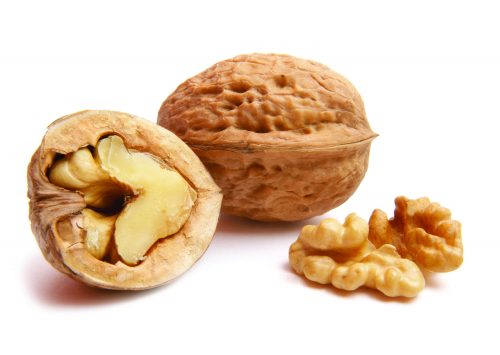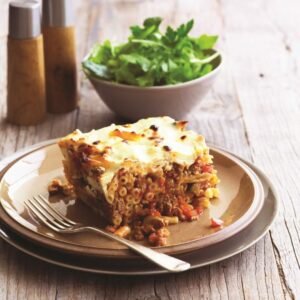
Walnuts
Walnuts are a good source of heart-healthy omega-3 fats. Studies have shown eating walnuts can decrease both total and LDL cholesterol (the bad one).
Use
Fresh creamy walnuts in the shell are available now — if you can find them, they really are superior to packaged nuts. Their mild flavour and pleasing crunch make them so versatile — add them to a smoothie, scatter on top of porridge, blend them into a walnut butter or dip, add them to pasta, use in pesto or enjoy them in baking and desserts. Store walnuts in a cool, dry place for up to three months or, if shelled, refrigerate, tightly covered, for up to six months. Walnuts can also be frozen for up to a year.
Recipe idea
Apricot, walnut and thyme muffins
Baby spinach
Baby spinach is a good source of vitamin A and folate, and also contains iron. The iron is more readily released if eaten with fruit containing vitamin C, so add mandarin or kiwifruit to a baby spinach salad for an iron and vitamin C boost.
Use
Baby spinach is available in supermarkets these days pre- washed and in handy 120g packs — the perfect amount for an easy side salad. Remember, too, that handfuls of baby spinach can be added in the final minutes of cooking to one-pot dishes, casseroles, stir-fries and soups, or they can be the main ingredient of a great winter salad. Packaged baby spinach must be consumed within a few days as it quickly wilts and turns slimy if left too long.
Recipe ideas
Chickpea, nut and cranberry salad
Vege fajitas
Ginger
Spices contain high concentrations of antioxidants and phytonutrients that potentially provide long-term health benefits. Ginger contains natural anti-inflammatory compounds and, although there is only limited evidence, has been found to reduce nausea and vomiting.
Use
The fresh ginger in our supermarkets is imported but it can be grown in warmer areas here and harvested year-round. Ginger is a wonder ingredient: cut slices to flavour soups, poach chicken or infuse milk for desserts; cut into matchsticks for texture and flavour in stir-fries; or grate it for a hit of ginger essence in dressings and dipping sauces. Store in the vegetable drawer of your fridge for up to two weeks, or tightly wrap it and freeze it.
Recipe ideas
Chicken tikka masala
Soba noodle soup with fish and Asian greens
Cabbage
Cabbage adds folate and fibre along with glucosinolates, compounds found in the brassica vegetables believed to be helpful in fighting cancer. It’s thought that cooking methods using less water, such as steaming, may retain more glucosinolates.
Use
You can’t beat cabbage when it comes to value for money, nutrition and versatility. At this time of the year, you can choose from green, red, Savoy, and the many Asian varieties. The popular Chinese cabbage (wong bok, above) is an oblong-shaped, pale yellow cabbage with a mild flavour. It is commonly used for kimchi (see page 78), and is also eaten raw, in stir-fries or soups. Store cabbage (including wong bok) in a plastic bag in the fridge for 1—2 weeks.
Recipe ideas
Sauerkraut and kimchi (see HFG Jul 2016 issue)
Soba noodle soup with fish and Asian greens
Article sources and references
- FoodWorks 8, Professional Edition. 2015. Xyris Software (Australia) Pty Ltdhttps://xyris.com.au/
- Herr I & Buchler MW. 2010. Dietary constituents of broccoli and other cruciferous vegetables: Implications for prevention and therapy of cancer. Cancer Treatment Reviews 36:377-83https://www.ncbi.nlm.nih.gov/pubmed/20172656
- Baghurst K 2006. Herbs and Spices - An integral part of the daily diet. Position Paper. In association with the National Centre of Excellence in Functional Foods (NCEFF), Australia.https://bit.ly/2ldYu1P
- Ernst E & Pittle MH. Efficacy of ginger for nausea and vomiting: a systematic review of randomised clinical trials. British Journal of Anaesthesia 84:367-71https://www.ncbi.nlm.nih.gov/pubmed/10793599
- Banel DK & Hu FB. 2009. Effects of walnut consumption on blood lipids and other cardiovascular risk factors: a meta-analysis and systematic review. American Journal of Clinical Nutrition 90:56-63https://www.ncbi.nlm.nih.gov/pubmed/19458020
- Kris-Etherton PM et al. 2003. Omega-3 fatty acids and cardiovascular disease. Arteriosclerosis Thrombosis and Vascular Biology 23:151-2https://www.ncbi.nlm.nih.gov/pubmed/12588750
www.healthyfood.com










